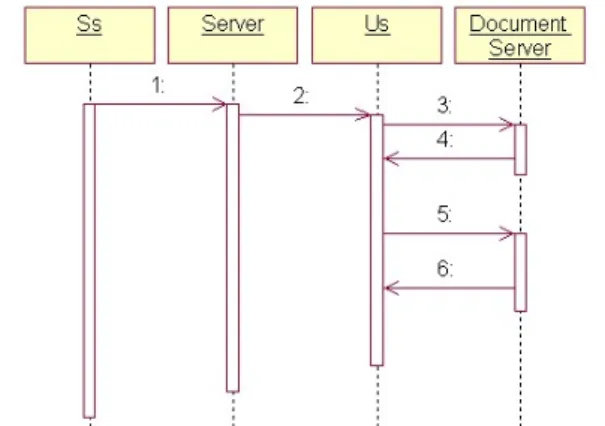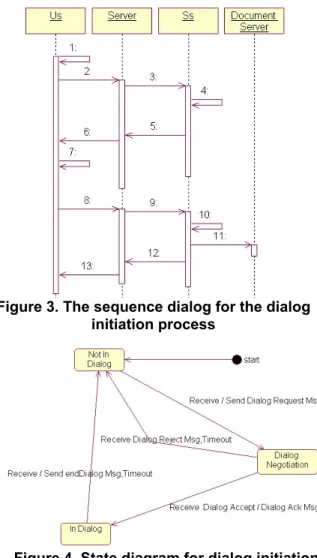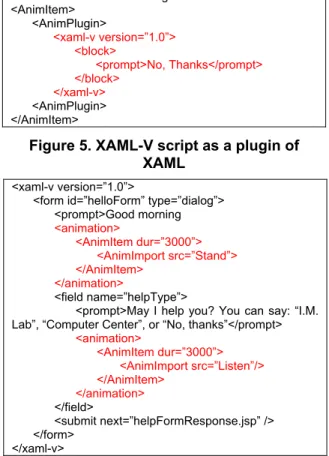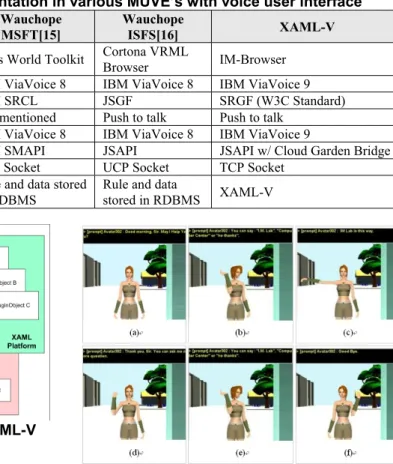Incorporating Voice Dialogs in a Multi-user Virtual Environment
Chun-Feng Liao and Tsai-Yen Li
Computer Science Department, National Chengchi University
{try,li@nccu.edu.tw}
Abstract
- The applications of 3D virtual environ-ments and voice user interface (VUI) on personal computers has received significant attentions in re-cent years. Since speech is the most natural way of communication, incorporating VUI into virtual envi-ronments can greatly enhance user interaction and immersiveness. Although there have been many re-searches addressing the issue of integrating VUI and 3D virtual environment, most of the proposed solu-tions do not provide an effective mechanism for multi-user dialog management. The objective of this research is on providing a solution for VUI integra-tion and dialog management and realizing such a mechanism in a multi-user virtual environment. We have designed a dialog scripting language called XAMLV (eXtensible Animation Markup Language -Voice Extension), based on the -VoiceXML standard, to address the issues of synchronization between VUI and animation and dialog management for multi-user interaction. We have also realized such a language on a multi-user virtual environment to evaluate the effectiveness of this design.Keywords: Voice User Interface, VoiceXML, Dia-log Management, Multi-user Virtual Environment.
1. Introduction
Due to the rapid development of graphics hard-ware and softhard-ware, virtual reality that used to run on high-end graphics workstation can now be experi-enced on desktop computers. Among the potential applications, Multi-User Virtual Environment (MUVE) is one that allows many users to share their experiences in a 3D virtual environment [11]. The nature of this type of system requires tight integra-tion of 3D graphics and distributed system technolo-gies. An example application of this type of envi-ronment is the prevalent 3D on-line games that have received significant attentions in recent years. Other applications on military, entertainment, education, etc. are also emerging [2][15].
Most MUVE systems today, such as DIVE[4] and ActiveWorld[1], adopts a multi-model user interface consisting of 3D navigation and textual chatting. However, few of them have incorporated voice user interface, the most natural way of communication for humans, into their systems, despite the recent ad-vances in speech-related technologies. We think the main reasons are two-fold. First, there exists no ef-fective dialog management mechanism for multiple users across the network in general. Most of the
voice applications today are simple applications fo-cusing on the voice dialogs between a human and a machine playing the role of the other human. Second, there is no flexible way to integrate dialog specifica-tions seamlessly into a computer-generated anima-tion in the current MUVE systems.
In this paper, we propose a dialog management mechanism that enables the voice user interface in a multi-user virtual environment. The mechanism uses a protocol to let two avatars, representing either hu-mans or machines, to establish a dialog connection and allow other avatars in the virtual world to ob-serve the progress of the dialog. The protocol is an XML-based document while the dialog itself is a form based on VoiceXML [14]. Due to the extensi-bility of XML, this dialog management mechanism is seamlessly integrated into a MUVE system called IMNet that adopts XAML (eXensible Animation Mockup Language) [10] as the underlying animation scripting language. The voice interface is described with a language called XAML-V and embedded in an XAML script as a plug-in which can in turn trig-ger additional animation scripts inside the dialog.
In the next section, we will briefly review the re-lated work in multi-user virtual environment and dialog management. In Section 3, we will describe the requirements of enabling voice dialogs in a MUVE. We will then present the design of XAML-V for realizing such a voice interface in the follow-ing section. In Section 5, we will describe some im-plementation issues and illustrate our design with an example dialog among multiple users. Finally, we will conclude the paper with some future research directions.
2. Related Work
2.1. Multi-user virtual environments According to the way that a message is propa-gated among the users, one can roughly classify the architecture of a MUVE into two categories: client-server and peer-to-peer. In a client-client-server architec-ture, all client messages are sent to the server which in turn broadcasts the messages to all other cli-ents[1][3]. The most common problem about this architecture is that the server can easily become a bottleneck when the number of clients rises. How-ever, most MUVE systems today adopt this architec-ture for its implementation simplicity. On the other hand, the MUVE systems adopting a peer-to-peer architecture communicate without a centralized
trol [5][6]. However, these systems are more difficult to implement and manage than the client-server ar-chitecture. Since system architecture is not the main concern of this work, we have chosen a MUVE sys-tem called IMNet (Intelligent Media Net)[9] with the client-server architecture.
In addition to the issue of system architecture, the application protocol for delivering multi-modal con-tents, such as 3D animation and textual chat, has also been an active research topic. A recent focus is on designing an XML-based animation scripting lan-guage for describing the activities in a virtual envi-ronment. For example, Avatar Markup Language (AML) [8] focuses on facial expression but only provides limited functions for altering a canned mo-tion. STEP is another XML-based scripting language that emphasizes on its logical reasoning ability [7]. XAML is also an XML-based animation scripting language featuring its extensibility in modeling an-imations with various levels of controls and allowing other external modules to be incorporated as plug-in [10]. In this work, we have chosen to extend XAML to incorporate a mechanism for voice dialog man-agement in the IMNet system.
2.2. Dialog management
The researches for core voice technologies, such as speech synthesis and recognition, and voice appli-cations have made significant progresses in recent years. International standards such as VoiceXML are emerging as the de facto for dialog-based applica-tions. Most of these designs aim to provide a voice user interface to a user by downloading a dialog form from a document server. However, since two-way communications between a human and a com-puter are usually the basic assumption for designing such a language, it cannot be directly applied to a MUVE system without modifications.
Galatea[13] is an Anthropomorphic Spoken Dia-log Agent (ASDA) platform that makes use of the dialog model of VoiceXML. It extends VoiceXML to incorporate animation descriptions such as facial expression scripts. However, in [12], the authors argue that the form-filling mechanism in VoiceXML is insufficient for expressing state transitions in an advanced dialog. Therefore, a language called Dia-logXML is designed to express a more complex dia-log. A dialog manager is also designed to translate the scripts in this language into VoiceXML scripts at run time.
3. Dialog Management in MUVE
VoiceXML was originally designed for dialogs between human and system in a telephony environ-ment. A human user interacts with the system by retrieving a sequence of dialog forms from a docu-ment server just as we do in a typical session of a web application. In such an environment, there are at most two interactive instances in a dialog session. However, in a typical MUVE, the number of avatars
in a scene is usually much larger. In a dialog session, two avatars are the active subjects while the other avatars act as observers. In order to clarify the roles of the avatars in a typical MUVE, we have adopted the following notations.
Subjects: Avatars in a dialog. Observers: Avatars not in a dialog. U: Avatars controlled by human. S: Avatars controlled by system. Suffix s: Subject avatars.
Suffix i (i=1,2,3…): Observer avatars.
For example, Us denotes an avatar in dialog con-trolled by a human user.
If we adopt the dialog model of a typical VoiceXML session between two avatars controlled by a human (Us) and a machine (Ss), the dialog may actually happen between Us and the document server as shown in Figure 1. After the dialog is initialized, Ss sends its dialog script’s URL to Us (steps1-2), and then Us fetches the script according to this URL from the document server, and collects inputs from the user. A new script is then fetched based on the user’s response (steps 3-6).
When applying the VoiceXML dialog model to a MUVE as described above, we encountered several problems. First, although Ss is in a dialog with Us, Ss is not aware of the dialog status after sending out the URL of the first dialog script. If some network fail-ures occur during the dialog or Us deliberately stops the dialog, Ss will not be notified and updated. Sec-ond, without a mechanism to maintain the dialog status, Ss may be talking to two or more avatars si-multaneously or showing a mixed and confused ani-mation to a wrong target. Therefore, we have pro-posed several mechanisms as described below to enhance the original dialog model.
3.1. Proxy request
In order to make Ss be aware of the dialog status when talking with Us, we propose to use a proxy-request mechanism as for a proxy server on WWW.
Figure 1. Sequence diagram of applying the VoiceXML dialog model to a MUVE
In the enhanced model, all dialog requests must pass through Ss as shown in Figure 2.
With the Proxy-Request mechanism, Ss will re-ceive all messages sent by Us, and thus be aware of its dialog status with Us. Therefore, Ss can detect and recover from potential errors. Since the participants of a dialog are all aware of the dialog status, the re-alization of many advanced dialog management mechanisms such as dialog initiation and locking as described below then become possible.
3.2. Dialog initiation and locking
Another characteristic of a dialog in a MUVE is that a user can only dedicate to a dialog session at one time. From our daily experience, we know that the output voice from one to many people is com-mon but input voice from many people to a person is unusual. For instance, when a teacher is giving a lecture to her students, the voice is one-to-many. When many students speak out for questions at the same time, it is difficult for the teacher to understand all the questions. Therefore, we think that for a valid dialog, the output from an avatar to others may have a one-to-one or one-to-many relationship; but input from others to the avatar should only allow one-to-one relationship. To realize such a mechanism, we need to design a dialog initiation and locking process to maintain dialog states appropriately.
Before any clients can start their dialogs, they must negotiate with the other dialog partner to en-sure that it is not in a dialog already. We have de-signed a two-round negotiation process as illustrated in Figure 3. Assume that Us intends to have a dialog with Ss. First, Us has to confirm that it is not in a dialog already with other clients in order to start the initiation process (step 1 in Figure 3). If this is the case, Us will enter the “dialog negotiation” state (see Figure 4) and send a “dialog request” message to Ss (steps 2~3). If Ss is also not in a dialog, it will enter “dialog negotiation” state as well and return a “dia-log accept” message (steps 5~6) back to Us. When Us receives this message, it will enter the “in dialog” state and send back a “dialog accept acknowledge-ment” message (steps 8~9). Ss then will also enter the “in dialog” state and fetch the first dialog script
from the document server for Us (steps 10~13). On the other hand, if Ss is busy in another dialog already in step 4, it will send back a “dialog reject” message. When Us receives this message or the process times out due to any abnormal network problems, it will enter the “not in dialog” state and abort the initiation process.
3.3. Dialog message types
The dialog initiation messages described above are sent between the two engaging parties only. However, after the dialog session starts, different avatars in a MUVE should receive different mes-sages due to their distinguished roles in the dialog. For example, except for the engaging avatars, the other avatars are observers of the dialog. They should receive the content of the dialog but should not participate or reply to any of these dialogs. Therefore, two types of messages are designed: dia-log scripts and broadcasting scripts. The diadia-log scripts are similar to a typical VoiceXML dialog form while the broadcasting scripts are like a dialog without questions. The dialog scripts are mandate and cannot be ignored while the broadcasting scripts may be safely ignored by other avatars if necessary. Figure 3. The sequence dialog for the dialog
initiation process
Figure 4. State diagram for dialog initiation and locking
Figure 2. The sequence diagram of adopting the Proxy Request mechanism in a dialog
4. Design of XAML-V
A scripting language called XAML-V (XAML Voice extension), an extension of XAML, is de-signed to realize the voice user interface and dialog management described in the previous section. In this section, we will describe the scripting language in more details to illustrate how it takes advantage of the extensibility of XAML to make the animation scripting language speech-enabled. XAML-V mainly consists of tags with two types of functions: dialog context and dialog management protocol.
4.1. Dialog context
XAML is an animation scripting language that al-lows other modules, such as XAML-V, to be incor-porated as plug-ins. As shown in Figure 5, a XAML-V script is enclosed in the <xaml-v> tag, which is embedded in an <AnimPlugin> tag. The dialog con-text part of XAML-V is based on a subset of VoiceXML with the telephony-related elements re-moved since they are not appropriate in MUVE. For example, the tags of <block>, <prompt>, <form>, and <field> all bear the same meanings as they are in VoiceXML while <transfer>, <filled>, and <assign> are removed.
In addition to the VoiceXML-related tags, XAML-V also supports embedded animations inside a dialog at both the form level and the field level.
The embedded animations are XAML scripts that do not recursively include XAML-V scripts. For exam-ple, in Figure 6, a form-level and a field-level anima-tion that imports canned moanima-tions from external files through the <AnimImport> tag is used.
The XAML-V script example in Figure 6 de-scribes a scenario where a computer-controlled ava-tar welcomes the user by a greeting statement “Good Morning, sir. May I help you?” Then the system asks the user where he/she is interested in going while playing a high-level ”listen” animation clip at the same time to prompt the user for a response. The response will then be sent to the given URL for fur-ther processing.
4.2. Dialog management protocol
Several tags are added to support the dialog man-agement mechanism proposed in the previous sec-tion. Figure 7 shows an example of dialog negotia-tion message. The “context” attribute indicates the type of dialog negotiation being executed, and the “source” attribute indicates where this message is from.
In Figure 7, the “context” attribute is “request”, and the “source” is “Us”. The script means that an avatar “Us” would like to “request” a conversion with the user. The possible values for the “context” attribute of the dialog-negotiation element include: request, accept, reject, dialogAck, and endDialog. Each of these values maps to an action in a dialog negotiation process described in the previous section. Figure 8 shows an example of the Proxy Request mechanism in XAML-V. The idea is to encapsulate HTTP GET/POST messages in the <proxy-request> tag such that the system-controlled avatar can fetch the next document from the document server. In the <proxy-request> element, the HTTP method, re-questing URL, and rere-questing parameters are the sub-elements to encapsulate detail information.
<?xml version=”1.0” encoding=”UTF-8”?> <AnimItem> <AnimPlugin> <xaml-v version=”1.0”> <block> <prompt>No, Thanks</prompt> </block> </xaml-v> <AnimPlugin> </AnimItem>
Figure 5. XAML-V script as a plugin of XAML
<xaml-v version=”1.0”>
<form id=”helloForm” type=”dialog”> <prompt>Good morning <animation> <AnimItem dur=”3000”> <AnimImport src=”Stand”> </AnimItem> </animation> <field name=”helpType”>
<prompt>May I help you? You can say: “I.M. Lab”, “Computer Center”, or “No, thanks”</prompt> <animation> <AnimItem dur=”3000”> <AnimImport src=”Listen”/> </AnimItem> </animation> </field> <submit next=”helpFormResponse.jsp” /> </form> </xaml-v>
Figure 6. Embedding animation in a XAML-V script
<proxy-request>
<method>GET</method> <url>helloFormResponse.jsp</url> <parameter>
<param key=”helpType” value=”no thanks”/> </parameter>
</proxy-request>
Figure 8. An XAML-V script for proxy re-quest
<xaml-v> <protocol>
<dialog-negotiate source=”Us” context=”request”/> </protocol>
</xaml-v>
5. Implementation and Example
5.1. Implementation
We have implemented the enhanced dialog model with XAML-V in IMNet [9][10]. The XAML-V module serves as a plug-in component of the XAML platform and coordinates with various input and out-put devices. The XAML-V module interprets XAML-V script ands manages several dialog mecha-nisms (e.g. dialog lock or dialog state). A comparison of the implementation of XAML with other speech-enabled MUVE systems is summarized in Table 1.
Figure 9 shows the overall architecture of XAML-V platform. The VoicePluginObject serves as a plug-in point to XAML platform. It accepts scripts from the XAML platform and delegate to a XAML-V interpreter. The XAML-V interpreter is the core of the XAML-V platform, which parses incom-ing scripts and orchestrates the other components. ExecutionContext is the data store for run-time con-figurations and information needed by the interpreter. The dialog document server is a repository for dialog scripts. These scripts may also be generated dynami-cally using server-side scripting technologies. For example, we use an open source Java Servlet con-tainer (Tomcat 4.1) as the dialog document server in our implementation. The HttpClient fetches dialog scripts from the document server and handle HTTP protocol details for the interpreter. Tag Handlers are collections of classes conformed to a “TagHandler”
interface, and each of them is designed to handle a specific tag. The interpreter delegates work to this component according to the tags that it encounters. For example, it will delegate work to PromptTa-gHandler class if the interpreter encounters a <prompt> tag. In addition to rendering the voice with the TTS module, the PromptTagHandler object will send out a broadcasting message containing a <prompt> script to let all other avatars render the voice as observers.
According to the plug-in model of XAML, when the interpreter encounters the <AnimPlugin> element, it will search a pre-configured component registry for a valid plug-in to handle the script described in-side the <AnimPlugin> element. The XAML inter-preter will acquire the control of current executing thread and delegate to a plug-in component when it finds one. Since XAML-V is actually the plug-in component, the XAML-V interpreter will take over the control of current thread and continue to execute the script.
5.2. An Example
In Figure 10, we show the snapshots of the user interface for an example of interactive animation with a voice dialog written in XAML and XAML-V. The example dialog script is similar to the one shown in Figure 6. In the scenario, a virtual charac-ter acts as a receptionist via the voice user incharac-terface when a real user enters the virtual environment. The Table 1. Comparison of implementation in various MUVE’s with voice user interface
System Cernak[4] Wauchope MSFT[15] Wauchope ISFS[16] XAML-V
Virtual
environment VRAC’s C6 EA’s World Toolkit
Cortona VRML
Browser IM-Browser
Speech recognition CSLU Toolkit IBM ViaVoice 8 IBM ViaVoice 8 IBM ViaVoice 9
SR grammar Home made IBM SRCL JSGF SRGF (W3C Standard)
SR invocation Keyword Not mentioned Push to talk Push to talk
TTS Festival IBM ViaVoice 8 IBM ViaVoice 8 IBM ViaVoice 9
Speech API Not mentioned IBM SMAPI JSAPI JSAPI w/ Cloud Garden Bridge
Speech-VR bridge TCP Socket TCP Socket UCP Socket TCP Socket
Dialog flow control SCI IDE Rule and data stored in RDBMS Rule and data stored in RDBMS XAML-V
Figure 10. Snapshots of the interface for an example dialog in a MUVE
Figure 9. System architecture of XAML-V platform
receptionist greets the guest by saying “Good morn-ing, Sir, May I help you?” (Figure 10(a)) Then he will listen to the user’s input for the destination that he/she is interested in and play a high-level anima-tion “listening” at the same time (Figure 10(b)). If the user does not need any assistance, the reception-ist will end the dialog by saying “Good-Bye” (Figure 10(f)). If the user specifies one of the destinations that the receptionist knows, she will guide the user to the destination (Figure 10(c)). Unless the user says “No, thanks”, the receptionist will continue to ask the user for further question (Figures 10(d) and (e)).
Figure 11 shows two snapshots (corresponding to (b) and (c) in Figure 10) of the dialog from the server’s view. The avatar with blonde hair is the ob-server of this dialog. She can hear all speech voices of the dialog, or may choose to ignore these voices safely if she would like to have a dialog with another avatar.
6. Conclusions and Future Work
In this paper, we have proposed to enhance MUVE with a voice user interface. We have pre-sented a dialog management mechanism for MUVE based on VoiceXML and XAML. The proposed XAML-V dialog scripting language includes func-tions on dialog lock, dialog broadcasting, dialog ne-gotiation, and a proxy request mechanism. We have demonstrated the appropriateness of this design by examples and shown that by integrating with an ap-propriate voice interface, users can communicate with each other in a more natural way in MUVE.
We have been focusing on realizing the dialog management mechanism for MUVE; however, many desirable features still need to be added to enhance the immersion of the virtual environment. For exam-ple, the volume of the voice dialog as well as other 3D sound effects should be adjustable according to the relative locations between avatars. In addition, a more attractive facial animation synchronized with the voice dialog should be adopted to enhance visual realism.
This work was partially supported by a grant from National Sci-ence Council under contact NSC 93-2213-E-004-001.
References
[1] ActiveWorlds,URL:<http://www.activeworlds.com>.
[2] O. Apaydin. “Networked Humanoid Animation Driven by Human Voice using Extensible 3D (X3D), H-Anim and Java Speech Open Standards,” Master’s Thesis, Naval Postgraduate School, March 2002. [3] Blaxxun, URL:<http://www.blaxxun.com>
[4] M. Cernak and A. Sannier, “Command Speech Inter-face to Virtual Reality Applications,” Technical Re-port, Virtual Reality Applications Center at Iowa State University of Science and Technology, June 2002.
[5] E. Frecon and M. Stenius, “DIVE: A Scalable net-work architecture for distributed virtual environ-ments,” Distributed Systems Engineering Journal (Special issue on Distributed Virtual Environments), Vol. 5, No. 3, pp.91-100, September 1998.
[6] C. Greenhalgh and S. Benford, “MASSIVE: a col-laborative virtual environment for teleconferencing,” ACM Trans. CHI, Vol.2, pp.239-261, 1995.
[7] Z. Huang, A. Eliens, and C. Visser, “STEP: A Scripting Language for Embodied Agents,” Proceed-ings of the Workshop on Lifelike Animated Agents, 2002.
[8] S. Kshirsagar, A. Guye-Vuilleme, and K. Kamyab, “Avatar Markup Language,” Proc. of 8th Euro-graphics Workshop on Virtual Environments, pp. 169-177, May, 2002.
[9] M.Y Liao, ”An Extensible Scripting Language for Interactive Animation,” Master’s thesis, Department of Computer Science, National Chengchi University, 2004.
[10] M.Y Liao and T.Y Li, ”A Scripting Language for Extensible Animation,” Proc. of 2003 Computer Graphics Workshop, Taiwan, 2003.
[11] M. Matijasevic, “A Review of Networked Multi-User Virtual Environment,” URL: <http://citeseer.nj.nec.com/matijasevic97review.html >, 1997
[12] E. Nyberg, T. Mitamura, P. Placeway, M. Duggan, and N. Hataoka, “DialogXML: Extending VoiceXML for Dynamic Dialog Management,” Proc. of the Human Language Technology Conf., 2002. [13] S. Sagayama, S. Kawamoto, H. Shimodaira, T. Nitta,
T. Nishimoto, S. Nakamura, K. Itou, S. Morishima, T. Yotsukura, A.Kai, A.Lee, Y. Yamashita, T. Ko-bayashi, K. Tokuda, K. Hirose, N. Moinematsu, A. Yamada, Y. Den, and T. Utsuro, “Galatea:An An-thropomorphic Spoken Dialogue Agent Toolkit,” IPSJ SIG-SLP, Feburary 2003
[14] VoiceXML, URL:< http://www.w3.org/Voice/> [15] K. Wauchope, “Interactive Ship Familiarization
System: Technical Description,” AIC Technical Re-port AIC-03-001, Navy Center for Applied Research in Artificial Intelligence, Washington DC, 2003. [16] K. Wauchope, S. Everett D. Tate, and T. Maney,
“Speech-Interactive Virtual Environments for Ship Familiarization,” Proc. of 2nd Intl. EuroConference on Computer and IT Applications in the Maritime Industries (COMPIT '03), pp. 70-83, Hamburg, Germany, May 2003.
Figure 11. Snapshots (b and c) of the above dialog from an observer’s viewpoint




